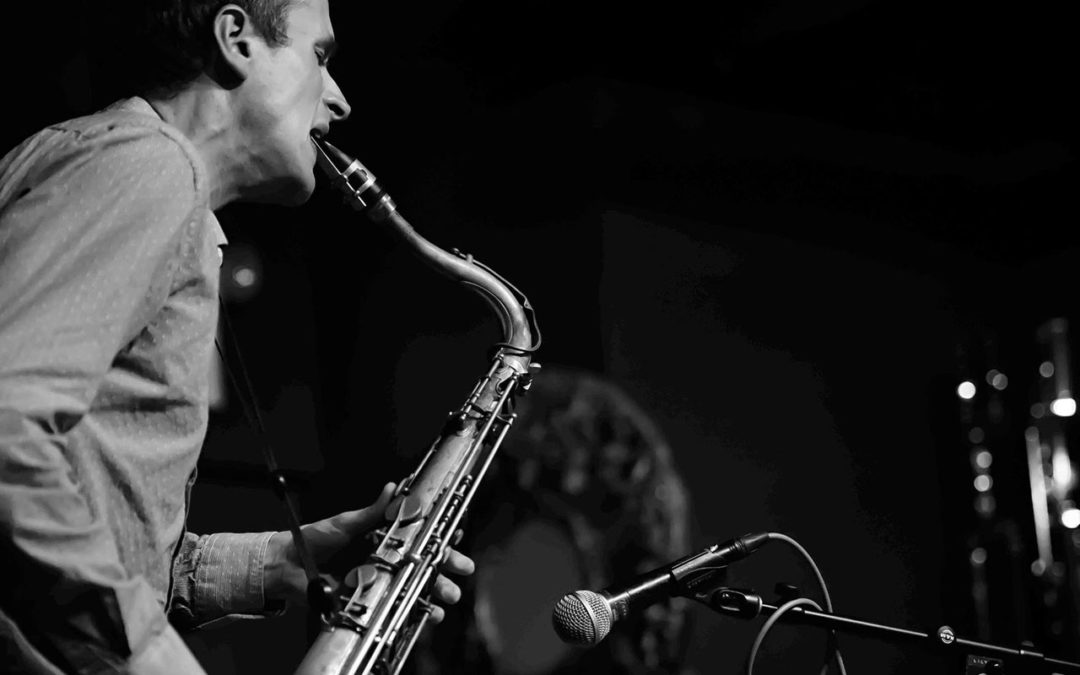Neil Welch image courtesy of the artist
COVID-19 has had profound effects on our community since our first community survey in March, 2020. We understand many performing artists are also private music instructors and teaching artists within education centers. We sent out an informal survey to our community in order to hear about individual experience over the last 5 months navigating teaching music lessons in a digital world. Below is a selection of those responses. Thank you to everyone who participated! A list of instructors can be found below.
Average Lessons Per Week
Of the 12 responders, 100% have continued to offer lessons over the last five months, with 58.3% offering remote/digital lessons for the first time. Prior to the COVID-19 pandemic, on average, 58.3% taught 7 or more lessons a week, 16.7% taught 4–6 lessons a week, 8.3% taught 2–4 lessons a week, and 16.7% taught 0–2 lessons a week. Since April, on average, the number of music lessons has remained the same, 58.3% reporting 7 or more per week, 16.7% reporting 4–6, 8.3% reporting 2–4, and 16.7% reporting 0–2 lessons per week. 83.3% of survey responders plan to continue to teach remotely after COVID-19 poses a lower risk (i.e. after a vaccine).
Kate Olson noted offering lessons remotely will depend on demand and the re-opening of the West Seattle Bridge, while Neil Welch responded that he “will likely offer makeup lessons online and will continue to teach some folks online where accessing lessons through in-person study is difficult. This includes students that find driving to lessons too costly time-wise or money-wise, or for those taking lessons online from a different city.”
Video Platforms & Learning Tools
Ranked most used to least used Zoom—91.7% have used Skype—50% have used FaceTime—66.7% have used Google Hangouts—33.3% have used JamKazam, Google Drive, Dropbox, Tonara, Teachable, and Canvas were mentioned often in the responses.
Joe Eck added, “The website ‘groovescribe’ has been HUGE for making online drum lessons more user friendly for myself and my students.” Dmitri Matheny offered this tip: “I keep my lesson notes in Evernote—really helps me stay organized especially because I can have it open on the desktop next to the Zoom window. I can even screenshot things I write out for them using Zoom’s “whiteboard” function, then drag it into Evernote right with my lesson notes. I can drag PDFs of stuff they’re working on into their lesson notes too.”
Challenges of Online Lessons
As one might imagine, teaching music online during a global pandemic (and subsequent economic crisis) comes with a host of challenges, most notably latency/reliability of connection, engagement/focus, and, of course, not being in the same room. Here’s what teaching artists had to say:
“1. It is largely impossible to play together at the same time with video chat software. The joyful, deeply human connectivity of simultaneous sound making in a room together is noticeably absent at every moment with online lessons. Sending videos back and forth is helpful—call and response is helpful—but nothing beats hearing each other’s sound bouncing back and forth in a room together. 2. I have found it very challenging to meet the various needs of my students with a strictly online learning format, particularly those with learning disabilities. 3. For many low-income students, online lessons are simply not feasible because of a lack of internet connection, unavailable funds to pay for lessons, and a lack of personal space to make music in their home environment. Online lessons require a strong (or at least decent) internet connection, a space in which to play music and money to pay for all that. The gap between wealthy and low-income students in my studio has widened. Prior to fully online lessons, I had far more low-income students in my studio. The access gap in private lessons was a tremendous problem that already existed in Seattle prior to COVID-19, and I anticipate it will be made worse through a predominantly online lesson format.” –Neil Welch
Benefits of Online Lessons
While teaching music online is, undoubtedly, a challenge, it’s not without its benefits—most notably, the lack of commute and the safety of remaining socially distant and healthy. Here’s what teaching artists had to say: “I love being able to use my own gear and not having to travel long distances to do lessons. A lot of my students have shown huge progress since switching to online as well.” –Joe Eck “1. I am a better prepared and more highly organized teacher now that I have learned to teach my full studio online. I have to speak with clarity and brevity when articulating my learning expectations. I talk less and play more. This has led to stronger musicianship from many of my students.
“Teaching songs is more difficult due to Wi-Fi lag. Some younger students have trouble keeping focused throughout the lessons.”–Joe Eck “It’s almost impossible to address tone production in any kind of meaningful way. It’s exhausting to be in front of a screen all day. My students’ internet connections are often spotty. We can’t play together due to latency.” –Kate Olson “Not being able to play in sync, hearing an accurate representation of my student’s sound, internet connection.” –Steve Treseler “Well, obviously it’s difficult with beginners especially not to be able to use touch to help them learn their basic technique. It’s resolvable via video chat; it just takes more words. In my studio, the more frustrating limitation is actually with advanced students who are building their improvisation and collaborative musicality skills. Not being able to play together, with a two-way flow of lag-free sound, really limits our ability to build those skills organically. It takes a lot of creative thinking to find ways to keep building those skills without that ability to play together.” –Kat Bula
” I have integrated recording technology into my lessons at a much more refined level since beginning to teach online full time. Students as well as myself have become accustomed to sending recordings, videos, using apps, creating pdf’s, generating music notation files, composing songs, etc. as part of a natural and fluid process in our collaboration. I am spending more hours at home and zero hours in traffic. This fills my spirit with more energy, and leaves me with more time and eagerness to tackle my own craft, even on days where I have a heavy teaching load.” –Neil Welch
“Besides not having to stop during a pandemic? I’d say the biggest [benefit] is about geography. I’ve had students from all over the world find me because they couldn’t find a local teacher. Local students were already availing themselves of online lessons at times, too—from their hotel rooms on business trips, from their home offices when they were on childcare duty or there was a snowstorm… or just because it was a particularly bad traffic day!” –Kat Bula
“No commute, no studio rent, wearing pajama bottoms, being able to work with students through the pandemic, and seeing many students dramatically improve because they have more time to practice.” –Susan Palmer
“Being able to develop skills and self-sufficiency that would have taken longer otherwise.” –Jory Tindall
Income
Prior to COVID-19 33.3% of those surveyed said that 50–75% of their income came from teaching. 25% reported 50–75% of income from teaching, 25% reported 0–25% income from teaching, 8.3% reported 25–50% income from teaching, and 8.3% said roughly 50%, varied month to month. In the last five months 75% reported that 75–100% of their income has come from teaching, with 25% reporting 0–25% of income from teaching
Preparing for Fall
As fall approaches and the reality of social distancing settles in for the long term, here’s how some teaching artists are preparing:
“Launching new online courses, collaborating with school music programs, developing group improvisation workshops over Zoom, starting a new company called Infinite Improvisation.” –Steve Treseler
“Thinking about creating more visual video learning content. Trying to plan group online classes so students can have interaction.” –Rachel Bade-McMurphy
“I am working hard to expand my understanding of online learning tools, such as recording technology and new collaborative music apps. I am connecting with parents, teachers, musicians, and students to discuss what kinds of learning styles and pedagogical techniques work best for each individual student. I am also working several hours per week to recruit new students in an effort to maintain income flow.” –Neil Welch
What Else Would You Like Us To Know
“Regular gig life probably isn’t coming back any time soon. I really think it would be in any musician’s best interest to start taking their work online in any capacity. I’m happy to help out anyone who would like some advice!” –Joe Eck
“I can’t wait for this to be over. At the start of the lockdown I was making 30–50% of my income from performing, and was considering raising the bar for entry into my private teaching studio. Now, all that performance income is gone, and I need my students more than they need me. It’s terrifying, humbling, and miserable all at the same time. I haven’t applied for income support because I am continuing to work, but I miss performing so much it’s like a physical ache.” –Kate Olson
“I am gravely concerned that there will be a “lost generation” of music students due to a lack of enrollment for elementary music study. Without the support of in-person learning and the fun and collaborative nature of a classroom, I fear many younger students will want to wait to join music classes for when they can resume in person, only to never actually give it a shot. As a performer and private teacher, I believe I have a responsibility to help the next generation of music students find their voice. This is all the more challenging with an online teaching format, but I must do my part to work creatively to help students find their way to musical study.” –Neil Welch
“It would be interesting to have a conversation about online group classes as well. I and several other music teachers I know have been exploring different strategies in this area. One thing that is surprising many of us is finding that many people actually really like being able to mute themselves during group play! It takes some pressure off while they’re building confidence. I wouldn’t want students to get addicted to that, but it’s fun to see that the disconnection is actually a silver lining for some folks at the same time that they’re getting to connect with other students in a class setting.” –Kat Bula
“I’ve developed more skills by moving all my teaching online; I have new ways of explaining/demonstrating concepts, and my lessons flow in a different way. I think students are getting a lot from online instruction, and I think when we get through COVID-19, there will be a new class of really incredible players to check out.” –Susan Palmer
Teaching Artists Available for Digital Lessons
Neil Welch (he/him)
Saxophone, clarinet, improvisation, and composition Neilwelch.com/lessons
Joe Eck (he/him)
Drums (651) 894.2059 joseph.eck28@gmail. com
Rachel Bade-McMurphy (she/her)
Clarinet, saxophone, voice Songvinemusic.com Imaginejazz.org
Kate Olson (she/her)
Saxophone, clarinet Kate.plays.sax@gmail. com Kateplayssax.com
Steve Treseler (he/him)
Saxophone, Improvisation stevetres@gmail.com stevetres.com
Jovino Santos Neto (he/him)
Piano, music history, theory Jovisan.net
Kat Bula (she/her)
Fiddle, violin, improvisation, applied music theory, guitar Hello@katbula.com Katbula.com
Dmitri Matheny (he/him)
flugelhorn, jazz improve, music business Dmitrimatheny.com
Susan Palmer (she/her)
Guitar Leadcatpress@gmail. com Leadcatpress.com





